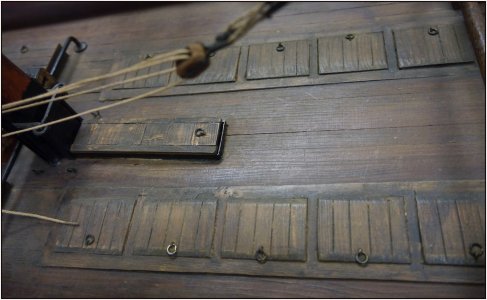Started working on the hatches. In addition to the technical drawing shown above, the Amsterdam restoration book also contains some old photos. The hatches are sometimes slightly raised.
They are also slightly raised in the model that Sybe de Jong made prior to the restoration:
View attachment 513393
I estimate that Sybe's model was built on a scale of 1:25.
First I made a test hatch entirely by hand. Based on that I was able to mill some details:
View attachment 513394
(Unfortunately not completely sharp with the iPhone.) The test is on the right and version 2.0 on the left. The hatch is 15.75 x 13.5 mm and 1 mm thick. The recessed rounding of 2 ø mm is 0.5 mm deep. The ring is recessed in it:
View attachment 513395
That can be seen in one of the details on the drawing. The eye of the eye bolt is also slightly recessed.
This is the result:
View attachment 513396
Made the 1 ø mm eye bolt and 2 ø mm ring from 0.4 ø mm iron wire.
Also with dowels for the connection with the clamps on the bottom:
View attachment 513397
With in the middle the clamp with hole for the lashing of the hatch.
Because you can look into it from the side, I will also secure some hatches with a rope later.
8 more hatches to go .......
Regards, Peter

















